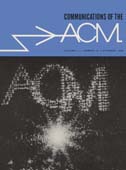October 1968 - Vol. 11 No. 10

Features
Scientific Applications: Computer synthesis of Holograms for 3-D display
Optical and digital holography are reviewed. The mathematical model and computational techniques of the authors' digital holographic process are discussed, and applications of computer holography are suggested.
Computer holograms have been made of three-dimensional objects which give faithful reconstructions, even in white light. A new approach based on point apertures for the image is discussed. Photographs of the images reconstructed from digital holograms are presented
Business Applications: GAN, a system for generating and analyzing activity networks
GAN, a system for generating activity networks, is designed to save time in the preparation of activity networks and to deal conveniently with network programs. A defining description of a programming language designed for generating activity network from a set of standard networks is presented. Also, a general idea of a language for performing calculations on activity networks (scheduling activity networks) is given.
Programming Languages: Boolean matrix methods for the detection of simple precedence grammars
The use of decision tables as a tool in systems analysis and for program specification is now becoming accepted. Rules on redundancy, contradiction, and completeness for limited entry tables were published in 1963. These are usually used for checking, preceded if necessary by a conversion from extended to limited entry form. Processors which automatically translate tables to more conventional program usually base their diagnostic facilities on these rules. In this paper it is suggested that these rules are unsatisfactory and that the important aspect of checking is to eliminate ambiguity from tables. Ambiguity is defined and discussed, and a procedure for producing checked-out decision tables is proposed. The theoretical basis of the algorithm used is established. The importance of well-designed diagnostic facilities in decision table processors is emphasized.
The implementation of a BASIC system in a multiprogramming environment
A mechanical procedure is derived for determining whether a given context-free phrase structure grammar is a simple precedence grammar. This procedure consists of elementary operations on suitably defined Boolean matrices. Application of the procedure to operator grammars is also given.
Easy English is a natural command language designed to simplify communication between man and machine through remote typewriter console. It has been developed for retrieval of documents from a computerized data base, the Moore School Information Systems Laboratory files. Requests are formulated in a standardized syntactical form (examples of which are presented), and this form is then transformed into an equivalent query expressed in the retrieval system's original Symbolic Command Language, which is briefly described.
Operation of Easy English is detailed by illustration of the transformations performed upon a sample request up to the point at which the request string is sent to the system. A macro flowchart of Easy English is included, and an Appendix provides the printout of a retrieval demonstration.
Education: A general-purpose display processing and tutorial system
ADEPT (A Display-Expedited Processing and Tutorial) system is described. This system was designed to improve man-computer communications by employing a display unit to interleave tutoring with other computer operations such as simulation, programming, and information retrieval. It is written in FORTRAN IV (G) for the IBM System/360, Model 40, and the IBM 2250 Display Unit under Operating System/360. ADEPT is a cataloged program that controls the standard operating system by terminating and rescheduling itself automatically, relinquishing computer resources allocated to it, and surrendering control to the operating system to perform other jobs. It expands the power and flexibility of computer-assisted instruction by making immediately available to students, teachers, and other users, the full resources (system-cataloged programs) of the operating system.
Language processors and compilers, simulation models, mathematical solution techniques, stored data, and all other library and user programs can be incorporated into instructional material without reprogramming. Illustrations of the various applications are presented and their implications are discussed.
0
Numerical Analysis: A fast fourier transform algorithm for real-valued series
A new procedure is presented for calculating the complex, discrete Fourier transform of real-valued time series. This procedure is described for an example where the number of points in the series is an integral power of two. This algorithm preserves the order and symmetry of the Cooley-Tukey fast Fourier transform algorithm while effecting the two-to-one reduction in computation and storage which can be achieved when the series is real. Also discussed are hardware and software implementations of the algorithm which perform only (N/4) log2 (N/2) complex multiply and add operations, and which require only N real storage locations in analyzing each N-point record.



